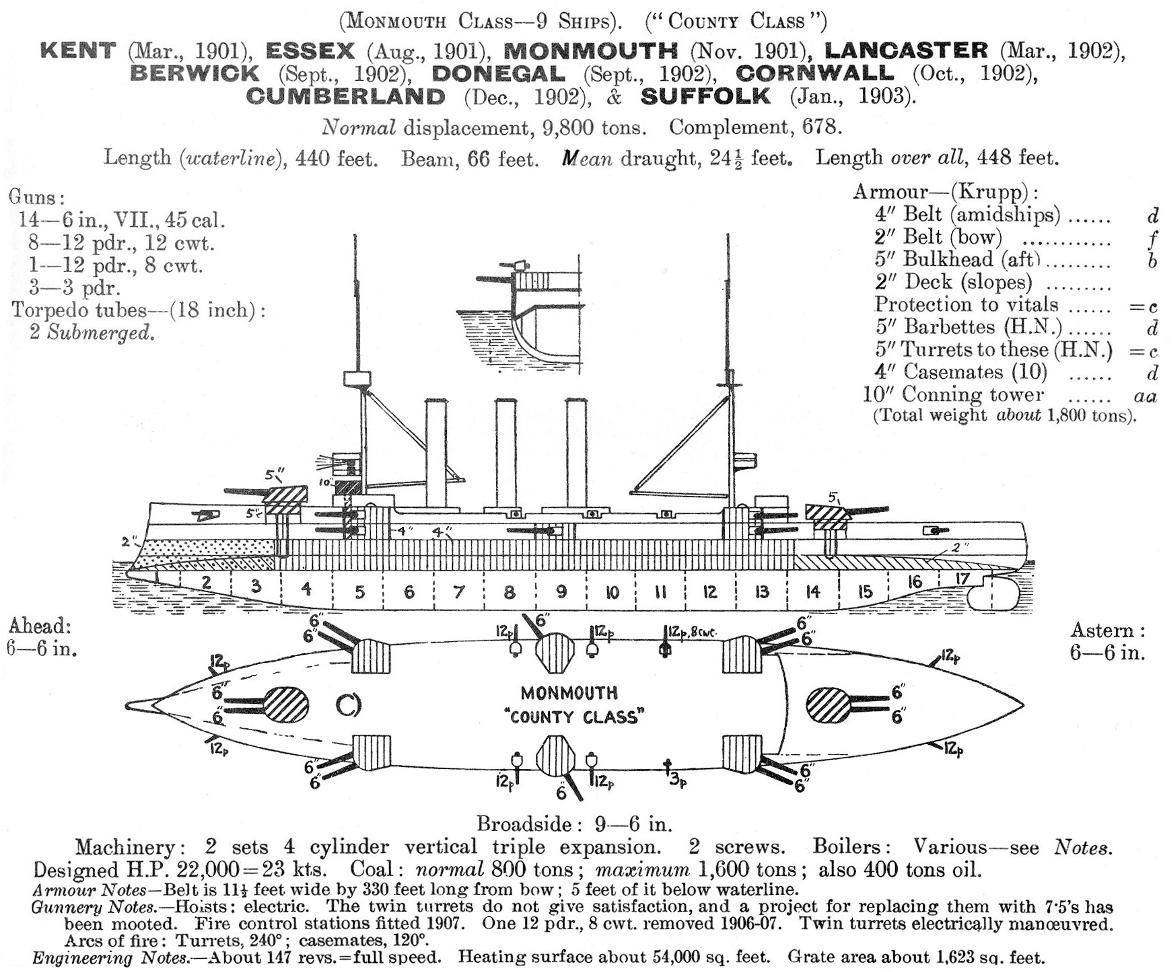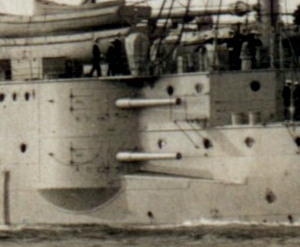Monmouth-class cruiser on:
[Wikipedia]
[Google]
[Amazon]
The ''Monmouth'' class was a ten-ship class of 10,000-ton armoured cruisers built around 1901 to 1903 for the

 Expected only to fight light cruisers and armed merchant ships, the class was armed with fourteen 6-inch guns at a time when most British armoured cruisers also carried at least a pair of 9.2-inch guns: Four of the guns were mounted in two twin turrets at a good height, the remaining ten were installed in hull-mounted casemates, five on each side. The lower casemate guns were just a few feet above water, making them impossible to use in heavy seas.
Expected only to fight light cruisers and armed merchant ships, the class was armed with fourteen 6-inch guns at a time when most British armoured cruisers also carried at least a pair of 9.2-inch guns: Four of the guns were mounted in two twin turrets at a good height, the remaining ten were installed in hull-mounted casemates, five on each side. The lower casemate guns were just a few feet above water, making them impossible to use in heavy seas.

 Upon completion, the ships served briefly in home waters before being assigned to various oversea stations (the
Upon completion, the ships served briefly in home waters before being assigned to various oversea stations (the
The Dreadnought Project
Technical details of the ships. {{DEFAULTSORT:Monmouth Class Cruiser Cruiser classes Ship classes of the Royal Navy de:HMS Monmouth (1901)#Die Schiffe der Monmouth- oder County-Klasse
Royal Navy
The Royal Navy (RN) is the United Kingdom's naval warfare force. Although warships were used by English and Scottish kings from the early medieval period, the first major maritime engagements were fought in the Hundred Years' War against ...
and designed specifically for commerce protection. The ships were also referred to as County class cruisers as they carried the names of British counties
A county is a geographic region of a country used for administrative or other purposesChambers Dictionary, L. Brookes (ed.), 2005, Chambers Harrap Publishers Ltd, Edinburgh in certain modern nations. The term is derived from the Old French ...
.
Design

 Expected only to fight light cruisers and armed merchant ships, the class was armed with fourteen 6-inch guns at a time when most British armoured cruisers also carried at least a pair of 9.2-inch guns: Four of the guns were mounted in two twin turrets at a good height, the remaining ten were installed in hull-mounted casemates, five on each side. The lower casemate guns were just a few feet above water, making them impossible to use in heavy seas.
Expected only to fight light cruisers and armed merchant ships, the class was armed with fourteen 6-inch guns at a time when most British armoured cruisers also carried at least a pair of 9.2-inch guns: Four of the guns were mounted in two twin turrets at a good height, the remaining ten were installed in hull-mounted casemates, five on each side. The lower casemate guns were just a few feet above water, making them impossible to use in heavy seas. Sir John Fisher
John Arbuthnot Fisher, 1st Baron Fisher, (25 January 1841 – 10 July 1920), commonly known as Jacky or Jackie Fisher, was a British Admiral of the Fleet. With more than sixty years in the Royal Navy, his efforts to reform the service helped t ...
commented that " Sir William White designed the County class but forgot the guns." On the other hand, they were relatively fast ships for their time.
Ships
The following table gives the build details and purchase cost of the members of the ''Monmouth'' class. Standard British practice at that time was for these costs to exclude armament and stores. The compilers ofThe Naval Annual
''The Naval Annual'' was a periodical that provided considerable text and graphic information (largely concerning the British Royal Navy) which had previously been obtainable only by consulting a wide range of often foreign language publications. ...
revised costs quoted for British ships between the 1905 and 1906 editions. The reasons for the differences are unclear.The 1906 figure for ''Monmouth'' is particularly high. but is as quoted in the original. The 1914 edition also quotes £979,591 as the cost of ''Monmouth''.
Service

 Upon completion, the ships served briefly in home waters before being assigned to various oversea stations (the
Upon completion, the ships served briefly in home waters before being assigned to various oversea stations (the China Station
The Commander-in-Chief, China was the admiral in command of what was usually known as the China Station, at once both a British Royal Navy naval formation and its admiral in command. It was created in 1865 and deactivated in 1941.
From 1831 to 18 ...
and the North America and West Indies Station
The North America and West Indies Station was a formation or command of the United Kingdom's Royal Navy stationed in North American waters from 1745 to 1956. The North American Station was separate from the Jamaica Station until 1830 when the ...
). During this time HMS ''Bedford'' was wrecked in the East China Sea and scrapped.
Following the outbreak of WW1, the ships were primarily tasked with combating German commerce raiders, patrolling in both the North and South Atlantic. HMS ''Monmouth'' was assigned to Rear Admiral Sir Christopher Cradock
Rear Admiral (Royal Navy), Rear Admiral Sir Christopher "Kit" George Francis Maurice Cradock (2 July 1862 – 1 November 1914) was an English senior officer of the Royal Navy. He earned a reputation for great gallantry.
Appointed to the royal ...
's squadron, and was sunk at the Battle of Coronel
The Battle of Coronel was a First World War Imperial German Navy victory over the Royal Navy on 1 November 1914, off the coast of central Chile near the city of Coronel. The East Asia Squadron (''Ostasiengeschwader'' or ''Kreuzergeschwader'') ...
. HMS ''Kent'' was also assigned to Cradock's squadron, but failed to join in time; she remained at the Falklands and joined Admiral Sturdee's squadron, which also included HMS ''Cornwall''. In the ensuing Battle of the Falklands
The Battle of the Falkland Islands was a First World War naval action between the British Royal Navy and Imperial German Navy on 8 December 1914 in the South Atlantic. The British, after their defeat at the Battle of Coronel on 1 November, sen ...
, HMS ''Kent'' pursued and sank , while HMS ''Cornwall'' pursued and sank . HMS ''Kent'' continued the pursuit of , eventually locating her and forcing her to be scuttled at the Battle of Más a Tierra
The Battle of Más a Tierra was a World War I sea battle fought on 14 March 1915, near the Chilean island of Más a Tierra, between a British squadron and a German light cruiser. The battle saw the last remnant of the German East Asia Squadro ...
. Later HMS ''Cornwall'' participated in the blockade of in the Rufiji river.
After the war, several of the ships served briefly as training ships. All were withdrawn from service and scrapped in 1920–21.
Notes
Footnotes
Bibliography
* Brassey, T.A. (ed) The Naval Annual 1905 * * * * Leyland, J. and Brassey, T.A. (ed) The Naval Annual 1906 * * * *External links
The Dreadnought Project
Technical details of the ships. {{DEFAULTSORT:Monmouth Class Cruiser Cruiser classes Ship classes of the Royal Navy de:HMS Monmouth (1901)#Die Schiffe der Monmouth- oder County-Klasse